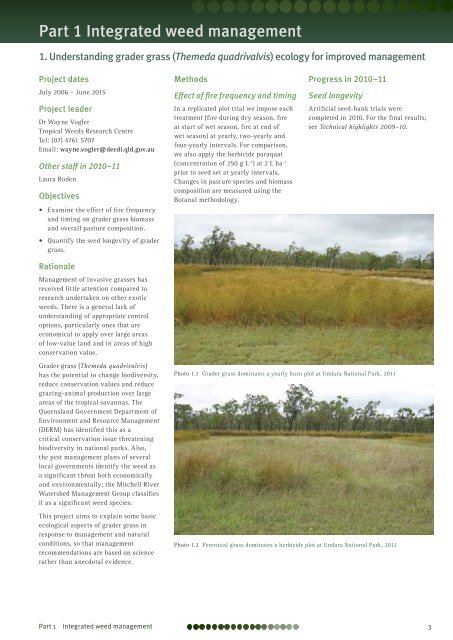Technical highlights - Department of Primary Industries ...
Technical highlights - Department of Primary Industries ...
Technical highlights - Department of Primary Industries ...
You also want an ePaper? Increase the reach of your titles
YUMPU automatically turns print PDFs into web optimized ePapers that Google loves.
Part 1 Integrated weed management<br />
1. Understanding grader grass (Themeda quadrivalvis) ecology for improved management<br />
Project dates<br />
July 2006 – June 2015<br />
Project leader<br />
Dr Wayne Vogler<br />
Tropical Weeds Research Centre<br />
Tel: (07) 4761 5707<br />
Email: wayne.vogler@deedi.qld.gov.au<br />
Other staff in 2010–11<br />
Laura Roden<br />
Objectives<br />
• Examine the effect <strong>of</strong> fire frequency<br />
and timing on grader grass biomass<br />
and overall pasture composition.<br />
• Quantify the seed longevity <strong>of</strong> grader<br />
grass.<br />
Rationale<br />
Management <strong>of</strong> invasive grasses has<br />
received little attention compared to<br />
research undertaken on other exotic<br />
weeds. There is a general lack <strong>of</strong><br />
understanding <strong>of</strong> appropriate control<br />
options, particularly ones that are<br />
economical to apply over large areas<br />
<strong>of</strong> low-value land and in areas <strong>of</strong> high<br />
conservation value.<br />
Grader grass (Themeda quadrivalvis)<br />
has the potential to change biodiversity,<br />
reduce conservation values and reduce<br />
grazing-animal production over large<br />
areas <strong>of</strong> the tropical savannas. The<br />
Queensland Government <strong>Department</strong> <strong>of</strong><br />
Environment and Resource Management<br />
(DERM) has identified this as a<br />
critical conservation issue threatening<br />
biodiversity in national parks. Also,<br />
the pest management plans <strong>of</strong> several<br />
local governments identify the weed as<br />
a significant threat both economically<br />
and environmentally; the Mitchell River<br />
Watershed Management Group classifies<br />
it as a significant weed species.<br />
This project aims to explain some basic<br />
ecological aspects <strong>of</strong> grader grass in<br />
response to management and natural<br />
conditions, so that management<br />
recommendations are based on science<br />
rather than anecdotal evidence.<br />
Methods<br />
Effect <strong>of</strong> fire frequency and timing<br />
In a replicated plot trial we impose each<br />
treatment (fire during dry season, fire<br />
at start <strong>of</strong> wet season, fire at end <strong>of</strong><br />
wet season) at yearly, two-yearly and<br />
four-yearly intervals. For comparison,<br />
we also apply the herbicide paraquat<br />
(concentration <strong>of</strong> 250 g L –1 ) at 2 L ha –1<br />
prior to seed set at yearly intervals.<br />
Changes in pasture species and biomass<br />
composition are measured using the<br />
Botanal methodology.<br />
Progress in 2010–11<br />
Seed longevity<br />
Artificial seed-bank trials were<br />
completed in 2010. For the final results,<br />
see <strong>Technical</strong> <strong>highlights</strong> 2009–10.<br />
Photo 1.1 Grader grass dominates a yearly burn plot at Undara National Park, 2011<br />
Photo 1.2 Perennial grass dominates a herbicide plot at Undara National Park, 2011<br />
Part 1 Integrated weed management 3

















